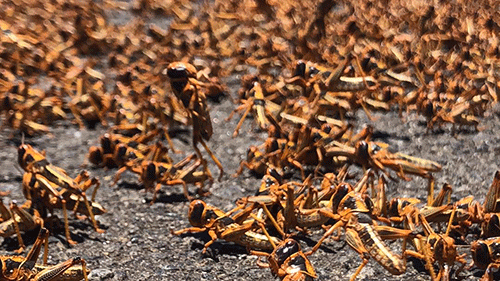The ministry of agriculture is battling to control the locust infestation detected in Karasburg in the //Kharas region which is destroying scarce grazing in that area.
Locustana Pardalina, better known as Brown Locust, breeds traditionally and propagates in the southern part of Namibia, mostly in the //Kharas region.
The core breeding areas of Brown Locust is around Karasburg East and Karasburg West constituencies, and in ǃNamiǂNûs constituency close to Aus settlement.
These areas have been receiving daily fly-in, mating egg-laying adult Brown Locust from neighbouring South Africa.
The ministry’s spokesperson Jona Musheko said the first outbreak was reported on 21 September 2021 by a commercial farmer, a team was immediately dispatched, unfortunately, they could not trace the small swarm. However, the initial control commenced on 3 November 2021 in the Karasburg district.
By then, the infested area was estimated at approximately 800 000 hectares of farmland, and over 240 000 ha surveyed with approximately 2 000 ha treated/sprayed.
The ministry is currently fighting the third locust outbreak in the Karasburg district.
“The good to fair rain received in the Ariamsvlei area, measuring up to 50 mm, has created a favourable breeding environment for locusts. Since mid-December 2021, we have been detecting swarms of brown locusts, spraying teams have been dispatched and are in the field till to date,” he said.
Asked about the extent of damage caused on farmland, Musheko could not provide such information as the ministry is still accessing the situation.
Nonetheless, Musheko confirmed, as of Wednesday, spraying was carried out at farm Nakop, up to Swartkop, covering approximately 80 000 ha.
“These first instar locusts are still hatching, they do not move much and did not form groups yet,” he noted.
However, he said there are large swarms of adult locusts that migrated through the area while reproducing, adding the ministry’s team have also spotted some instar locusts in the Karas mountains.
Given the landscape or terrains that are difficult to access and make scouting difficult, he says it is possible that there are more undetected first instar locusts and the ministry is expecting more reports in the next two weeks as soon as the locusts begin hopping.
The ministry appreciates the cooperation they are getting from farmers, and encourage farmers to continue monitoring or scouting their farms and report any new incidents of locust infestations at the agriculture office in Karasburg.
– anakale@nepc.com.na


